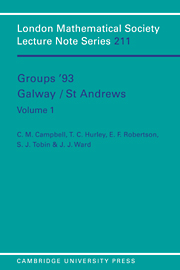Book contents
- Frontmatter
- Contents
- Preface
- Introduction
- Geometry, Steinberg representations and complexity
- The structure of metabelian finite groups
- Table algebras of extended Gagola-type and applications to finite group theory
- On the saturation of formations of finite groups
- Locally constructed formations of finite groups
- Reflections on virtually one-relator groups
- Rickard equivalences and block theory
- Computing the conjugacy classes of elements of a finite group
- Quotient categories of modules over group algebras
- Weak chain conditions for non-almost normal subgroups
- Computation of the character table of affine groups using Fischer matrices
- The lattice of compact representations of an infinite group
- Automorphisms of nilpotent and related groups
- Generation of orthogonal groups over finite fields
- The structure of certain Coxeter groups
- n-free groups and questions about universally free groups
- Classification of all generating pairs of two generator Fuchsian groups
- Parametric words and models of the elementary theory of non-abelian free groups
- The groups G(n, l) as fundamental groups of Seifert fibered homology spheres
- Lifting automorphisms: a survey
- (MI)-groups acting uniserially on a normal subgroup
- Revisiting a theorem of Higman
- Cohomological finiteness conditions
Computing the conjugacy classes of elements of a finite group
Published online by Cambridge University Press: 02 March 2010
- Frontmatter
- Contents
- Preface
- Introduction
- Geometry, Steinberg representations and complexity
- The structure of metabelian finite groups
- Table algebras of extended Gagola-type and applications to finite group theory
- On the saturation of formations of finite groups
- Locally constructed formations of finite groups
- Reflections on virtually one-relator groups
- Rickard equivalences and block theory
- Computing the conjugacy classes of elements of a finite group
- Quotient categories of modules over group algebras
- Weak chain conditions for non-almost normal subgroups
- Computation of the character table of affine groups using Fischer matrices
- The lattice of compact representations of an infinite group
- Automorphisms of nilpotent and related groups
- Generation of orthogonal groups over finite fields
- The structure of certain Coxeter groups
- n-free groups and questions about universally free groups
- Classification of all generating pairs of two generator Fuchsian groups
- Parametric words and models of the elementary theory of non-abelian free groups
- The groups G(n, l) as fundamental groups of Seifert fibered homology spheres
- Lifting automorphisms: a survey
- (MI)-groups acting uniserially on a normal subgroup
- Revisiting a theorem of Higman
- Cohomological finiteness conditions
Summary
Abstract
There are several problems associated with the computation of the conjugacy classes of elements of a finite group, for example, the computation of centralizers and the determination of conjugacy of two elements. The known algorithms for solving these associated problems and the main problem of determining the conjugacy classes are presented. The effectiveness of the algorithms is illustrated by examples. Some applications are briefly discussed.
Introduction
Let G be a finite group. The conjugate, xg, of an element x ∈ G by an element g ∈ G is the element g-1xg. Two elements x and y are conjugate in G if there exists g ∈ G such that xg = y. The relation of being conjugate in G is an equivalence relation on the set of elements of the group G. The equivalence classes are called conjugacy classes of elements. For each element g ∈ G, the map Φg : G → G defined by x ↦ xg is an automorphism of the group G. The maps are called inner automorphisms and they form a normal subgroup of the automorphism group, Aut(G), of G. Therefore, the elements in a conjugacy class are in the same orbit of Aut(G) in its action on G, and have similar properties. Hence, a set of class representatives contains one of each distinct “type” of element in the group.
- Type
- Chapter
- Information
- Groups '93 Galway/St Andrews , pp. 80 - 112Publisher: Cambridge University PressPrint publication year: 1995



